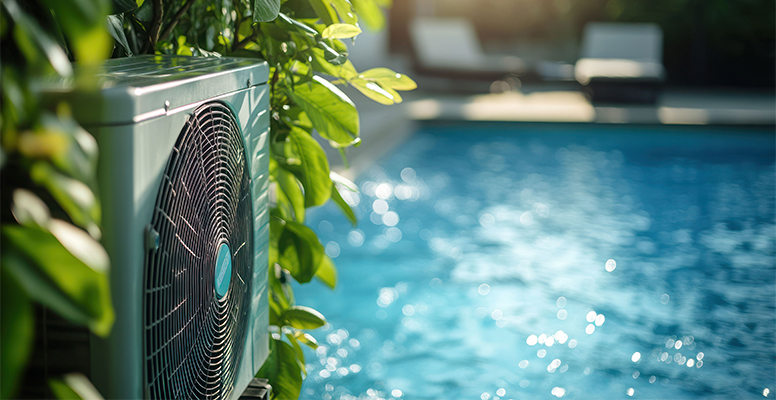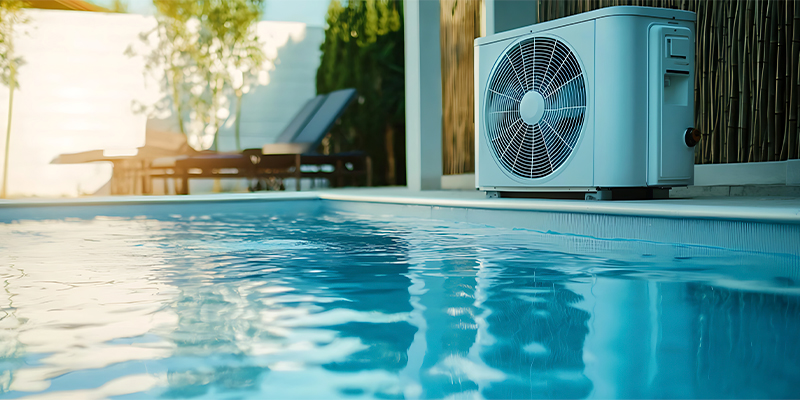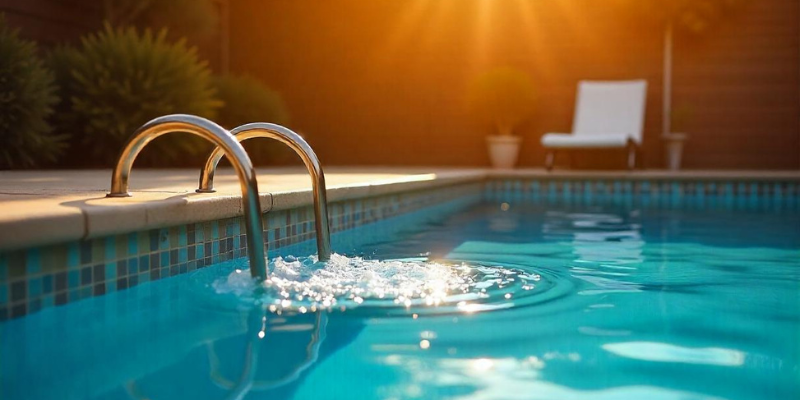 A pool heat pump will simply move the heat from the air to the water. Unlike a heater, it will not generate heat.
A pool heat pump will simply move the heat from the air to the water. Unlike a heater, it will not generate heat.
It’s great, useful, and affordable. It uses up to three times less energy than the electric resistance heater.
Oasis heat pump is one of the popular brands when it comes to pool heating. Let’s talk about why Oasis is popular and a few features that you get. This will help you understand the working better.
Oasis Heat Pumps: Features & Benefits
Thermo Pools offers Oasis heat pumps, which are popular choices and offer the following features:
- Available in inverter models (like the iX series) with variable-speed fans and compressors.
- Include smart controls such as touch screens, timers, and even PV (solar) integration options.
- Use titanium heat exchangers, which are long-lasting and resistant to pool chemicals.
- Feature defrost cycles to maintain performance in cooler air.
- Inverter models adjust output based on need, making them quieter at night and more efficient overall.
Here are the steps or stages on how a pool heat pump in Sydney works.
Step-by-step working of the Oasis Pool Heat Pump
Let’s get into the simple explanation of how a pool heat pump works in Sydney. We will see simple as well as technical explanations.
1. Air Intake & Heat Extraction
The first step is heat extraction.
- The pump’s fan draws in ambient air.
- Even if it’s a bit cool outside, that air contains heat energy.
- A refrigerant fluid in the heat pump absorbs this heat and then turns into a warm gas.
Air always holds some heat, even in lower temperatures. The refrigerant used in heat pumps has a very low boiling point.
Therefore, it can evaporate easily. This stage is basically the heat absorption part of the refrigeration cycle, similar to how your fridge pulls heat out of its interior, but here the heat is being pulled in for use.
2. Compressor Stage
Now comes the compressoir stage.
- That warm refrigerant gas goes into a compressor.
- The compressor increases its temperature and pressure—this makes it even warmer.
Compressing a gas increases both its pressure and temperature. Think of it like squeezing air into a bicycle tire, as you know, it gets hot. The compressor in the heat pump does the same to the refrigerant gas. The hotter the gas gets, the more effective it is at transferring heat to the pool water in the next stage. This is where the real energy boost happens in the system.
3. Heat Exchanger & Pool Water Loop
This is the main stage. Oasis heat pumps do this process faster. If you go with reputed brands, you will get better heating. That’s why branded pool heat pumps in Sydney are popular. Let’s talk about the process.
- The hot refrigerant passes through a titanium heat exchanger.
- Pool water circulates through the exchanger, absorbing the heat.
- Now, the water returns to your pool warmer than before.
The heat exchanger is where heat moves from the refrigerant to your pool water. Different heat pool heat pumps in Sydney use different materials. However, usually, Titanium is used because it resists corrosion from pool chemicals and handles high temperatures well.
The refrigerant gas flows through one side of the exchanger while pool water flows through the other. Since the gas is hotter, it transfers heat to the water without mixing. This is all about thermal conductivity and material safety.
4. Refrigerant Cooling & Cycle Repeat
Now comes the last stage.
- Inside, the refrigerant cools back to a liquid form.
- A valve regulates its pressure to start the cycle again.
After releasing its heat, the refrigerant needs to cool and return to a liquid state. This happens in the expansion valve. The valve drops the pressure of the refrigerant, which rapidly cools it down. From here, the cooled liquid returns to the start of the system, ready to absorb heat again. This cycle continues as long as the unit runs, making it a closed-loop system based on standard refrigeration principles.
Pool Heat Pumps vs Gas Pool Heaters
 Both systems are popular products of Thermo Pools, but they work very differently. If you’re curious about the mechanics, here’s a detailed look at how gas pool heaters work. Now, let’s talk about both systems and get a quick overview.
Both systems are popular products of Thermo Pools, but they work very differently. If you’re curious about the mechanics, here’s a detailed look at how gas pool heaters work. Now, let’s talk about both systems and get a quick overview.
Gas Pool Heaters
Let’s start with the gas pool heaters and how they work.
- It uses natural gas or propane to generate heat.
- Provide rapid heating, great for occasional use.
- However, they can be costly to run and produce carbon emissions.
- They have higher maintenance costs due to combustion parts.
Pool Heat Pumps
- Don’t generate gas heat; just move existing heat.
- Slower to heat but much more energy-efficient.
- Heat pumps are quieter and last longer with low-maintenance needs.
- An electric heat pump might run a few dollars a day, while gas heaters cost notably more.
So, if you’re after consistent heating and energy savings, pool heat pumps are a solid choice. But if you need to heat your pool really fast on demand, a gas pool heater might make sense, just expect higher running costs.
Final Verdict: Why Pool Heat Pumps Are Best for Pool Heating in Sydney
Sydney’s mild climate makes heat pumps particularly effective year-round. Even in cooler months, outdoor air holds enough heat to power a pump. Many models include a built-in defrost to keep operating in colder weather. So, if you’re in Sydney and want an efficient and cost-effective heating solution, contact Thermo Pools and get a pool heat pump is a reliable choice with low operating costs.
Want to know more about the Oasis pool heat pump? Call Thermo Pools on (02) 88 50 40 30 for expert advice.












